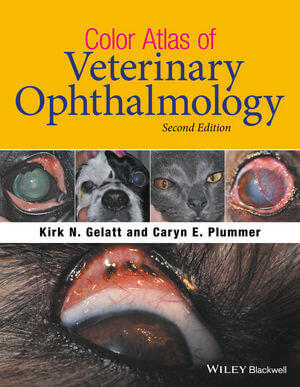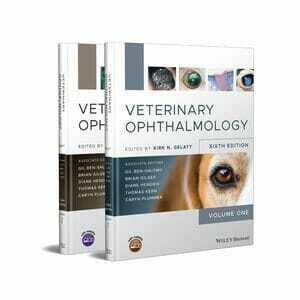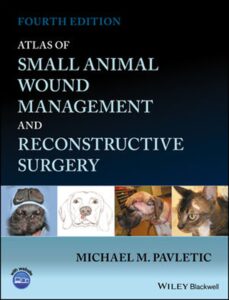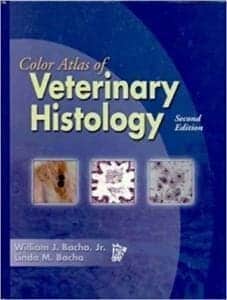Color Atlas of Veterinary Ophthalmology, 2nd Edition

By Kirk N. Gelatt and Caryn E. Plummer
Color Atlas of Veterinary Ophthalmology 2nd Edition PDF provides a compendium of the clinical appearance of ophthalmic diseases likely to be encountered in small, large, or exotic animal practice.
- Offers a pictorial reference to the clinical appearance of diseases and conditions of the animal eye
- Presents multiple presentations of most ophthalmic diseases to show the varying ways the condition might appear
- Provides more than 1,000 high-quality color clinical photographs showing ocular disorders
- Includes new introductory chapters on ocular anatomy, the ophthalmic exam, and clinical findings in place of the clinical signs chapter
- Covers clinical history, the clinical signs and findings associated with the disease, the rule-outs or differential diagnoses, the recommended treatment, and the prognosis for each disorder
Kirk N. Gelatt, VMD, Diplomate ACVO, is Distinguished Professor Emeritus at the University of Florida in Gainesville, Florida, USA.
Caryn E. Plummer, DVM, Diplomate ACVO, is Associate Professor of Comparative Ophthalmology and Service Chief of the Veterinary Ophthalmology Service at the University of Florida in Gainesville, Florida, USA.
Preface xv
1 Ocular Anatomy 1
Fig. 1.1 Eye anatomy 2
Fig. 1.2 Eyelid 5
2 The Ophthalmic Examination and Diagnostics 7
Fig. 2.1 Ophthalmic examination equipment 8
Fig. 2.2 Ophthalmic examination 10
Fig. 2.3 Ophthalmic examination in a horse 11
Fig. 2.4 Nasolacrimal patency 12
Fig. 2.5 Microbiologic culture and susceptibility testing 13
Fig. 2.6 Cytology 14
Fig. 2.7 Ophthalmic stains 15
Fig. 2.8 Slit lamp biomicroscopy 17
Fig. 2.9 Intraocular pressure 18
Fig. 2.10 Gonioscopy 19
Fig. 2.11 Ophthalmoscopy 20
3 Clinical Signs and Their Interpretations 25
Fig. 3.1 Blepharospasm 26
Fig. 3.2 Epiphora 27
Fig. 3.3 Exophthalmos/enophthalmos/strabismus 27
Fig. 3.4 Microphthalmia/phthisis bulbus/buphthalmos 29
Fig. 3.5 Conjunctival hyperemia 30
Fig. 3.6 Iridocyclitis 32
Fig. 3.7 Episcleral venous congestion 33
Fig. 3.8 Corneal edema 34
Fig. 3.9 Corneal ulceration/vascularization 36
Fig. 3.10 Corneal pigmentation 38
Fig. 3.11 Corneal cellular infiltrate 38
Fig. 3.12 Sequestrum 40
Fig. 3.13 Corneal fibrosis 41
Fig. 3.14 Corneal lipidosis 42
Fig. 3.15 Hemorrhages 43
Fig. 3.16 Opacity in the anterior chamber 45
Fig. 3.17 Mydriasis/miosis 46
Fig. 3.18 Posterior synechiae 47
Fig. 3.19 Rubeosis irides 48
Fig. 3.20 Acute chorioretinal inflammations 50
Fig. 3.21 Chronic chorioretinal inflammation 50
4 Canine Orbit 53
Fig. 4.1 Microphthalmia 54
Fig. 4.2 Acute orbital cellulitis/retrobulbar abscess 55
Fig. 4.3 Zygomatic salivary mucocele 56
Fig. 4.4 Acute masticatory myositis 57
Fig. 4.5 Bilateral polymyositis 58
Fig. 4.6 Microphthalmos/strabismus 59
Fig. 4.7 Traumatic proptosis 60
Fig. 4.8 Orbital trauma 62
Fig. 4.9 Craniomandibular osteopathy 62
Fig. 4.10 Orbital masses 63
Fig. 4.11 Enucleation 64
Fig. 4.12 Intraocular silicone prosthesis 65
Fig. 4.13 Phthisis bulbus 66
5 Canine Eyelids 67
Fig. 5.1 Ankyloblepharon 68
Fig. 5.2 Eyelid agenesis 68
Fig. 5.3 Dermoid 68
Fig. 5.4 Blepharophimosis 69
Fig. 5.5 Euryblepharon 69
Fig. 5.6 “V” notch in the central lower eyelid 70
Fig. 5.7 Entropion 71
Fig. 5.8 Ectropion 73
Fig. 5.9 Combined entropion–ectropion 74
Fig. 5.10 Distichia 75
Fig. 5.11 Ectopic cilia 76
Fig. 5.12 Trichomegaly 76
Fig. 5.13 Trichiasis 76
Fig. 5.14 Eyelid laceration 77
Fig. 5.15 Pyoderma blepharitis 78
Fig. 5.16 Sarcoptic mange 78
Fig. 5.17 Immune‐mediated blepharitis 79
Fig. 5.18 Pyogranulomatous blepharitis 79
Fig. 5.19 Uveodermatologic syndrome 80
Fig. 5.20 Meibomianitis 81
Fig. 5.21 Hordeolum/chalazion 82
Fig. 5.22 Proliferative keratoconjunctivitis 82
Fig. 5.23 Adenoma of the meibomian gland 83
Fig. 5.24 Melanoma of the lower eyelid 84
Fig. 5.25 Squamous cell carcinoma/mast cell tumor 84
Fig. 5.26 Histiocytoma 85
Fig. 5.27 Oral papillomatosis 85
6 Canine Tear and Nasolacrimal Systems 87
Fig. 6.1 Acute keratoconjunctivitis sicca 88
Fig. 6.2 Chronic keratoconjunctivitis sicca 90
Fig. 6.3 Sequelae of acute keratoconjunctivitis sicca 91
Fig. 6.4 Qualitative keratoconjunctivitis sicca 92
Fig. 6.5 Entropion 93
Fig. 6.6 Acute dacryocystitis 93
Fig. 6.7 Longer term dacryocystitis 94
Fig. 6.8 Dacryocele/dacryops 95
7 Canine Conjunctiva and Nictitating Membrane (Nictitans) 97
Fig. 7.1 Encircling nictitans 98
Fig. 7.2 Dermoid of the lateral bulbar conjunctiva 98
Fig. 7.3 Everted cartilage 99
Fig. 7.4 Prolapse of nictitans tear glands 100
Fig. 7.5 Bilateral protrusion of the nictitans 101
Fig. 7.6 Plasma cell infiltration of the nictitans 101
Fig. 7.7 Foreign bodies in the nictitans 102
Fig. 7.8 Primary neoplasms of the nictitans 103
Fig. 7.9 Conjunctivitis 104
Fig. 7.10 Follicular conjunctivitis 105
Fig. 7.11 Chemosis of the conjunctiva 106
Fig. 7.12 Subconjunctival hemorrhage 107
Fig. 7.13 Non‐neoplastic inflammatory masses of the conjunctivas and nictitans 108
Fig. 7.14 Neoplasms of the canine conjunctiva 109
8 Canine Cornea and Sclera 111
Fig. 8.1 Corneoconjunctival dermoid 112
Fig. 8.2 Ocular dysgenesis 112
Fig. 8.3 Persistent pupillary membranes 113
Fig. 8.4 Corneal erosion 114
Fig. 8.5 Corneal ulcer 115
Fig. 8.6 Central corneal ulcer 118
Fig. 8.7 Fungal keratitis 120
Fig. 8.8 Pigmentary keratitis 121
Fig. 8.9 Chronic superficial keratitis 122
Fig. 8.10 Neuroparalytic keratitis 124
Fig. 8.11 Neurotropic keratitis 125
Fig. 8.12 Keratitis 125
Fig. 8.13 Florida keratopathy 128
Fig. 8.14 Corneal laceration 128
Fig. 8.15 Corneal foreign bodies 130
Fig. 8.16 Corneal stromal dystrophies 132
Fig. 8.17 Endothelial corneal dystrophy 133
Fig. 8.18 Corneal degeneration 135
Fig. 8.19 Corneal cyst 137
Fig. 8.20 Limbal melanoma 138
Fig. 8.21 Scleral and conjunctival icterus 138
Fig. 8.22 Staphyloma 139
Fig. 8.23 Proliferative keratoconjunctivitis 139
9 Canine Glaucomas 143
Fig. 9.1 Optic nerve head and primary open angle glaucoma 144
Fig. 9.2 Optic nerve head changes in primary narrow/closed angle glaucoma 144
Fig. 9.3 Congenital glaucoma 145
Fig. 9.4 Congenital glaucoma 145
Fig. 9.5 Primary narrow/closed angle glaucoma 146
Fig. 9.6 Primary narrow/closed angle glaucoma with pectinate ligament dysplasia 148
Fig. 9.7 Primary narrow/closed angle glaucoma and globe enlargement 150
Fig. 9.8 Lens luxations or displacements 151
Fig. 9.9 Cataract formation, resorption, lens‐induced uveitis, and glaucoma 153
Fig. 9.10 Chronic uveitis/uveal cysts syndrome 155
Fig. 9.11 Secondary aphakic/pseudophakic glaucoma 157
Fig. 9.12 Traumatic glaucoma 157
Fig. 9.13 Secondary glaucoma from intraocular hemorrhage 158
Fig. 9.14 Pigmentary glaucoma 158
Fig. 9.15 Secondary glaucoma and malignant melanoma of the ciliary body 159
Fig. 9.16 Secondary glaucoma and ciliary body primary adenocarcinoma 159
Fig. 9.17 Secondary glaucoma and metastatic nasal adenocarcinoma 160
Fig. 9.18 Glaucoma secondary to anterior uveitis and lymphoma 160
Fig. 9.19 Glaucoma secondary to anterior uveitis and lymphoma 160
Fig. 9.20 Surgical and laser treatment for canine glaucoma 161
10 Canine Anterior Uvea 163
Fig. 10.1 Heterochromia iridis 164
Fig. 10.2 Merle ocular dysgenesis 165
Fig. 10.3 Persistent pupillary membranes 166
Fig. 10.4 Iridal nests 167
Fig. 10.5 Iridal coloboma 167
Fig. 10.6 Acute iridocyclitis 168
Fig. 10.7 Uveodermatologic syndrome/chronic anterior uveitis 170
Fig. 10.8 Anterior uveitis following rickettsial infestation 171
Fig. 10.9 Iridocyclitis following heartworm infestation 171
Fig. 10.10 Anterior uveitis secondary to infectious canine hepatitis 172
Fig. 10.11 Mycotic iridocyclitis and chorioretinitis 173
Fig. 10.12 Iridocyclitis and cataract 174
Fig. 10.13 Pigmentary uveitis 175
Fig. 10.14 Uveodermatologic syndrome 176
Fig. 10.15 Senile iris atrophy 178
Fig. 10.16 Anterior uveal trauma 179
Fig. 10.17 Hyphema 180
Fig. 10.18 Melanoma 182
Fig. 10.19 Ciliary body adenoma/adenocarcinoma 184
Fig. 10.20 Metastatic adenocarcinoma of the ciliary body 185
Fig. 10.21 Lymphoma 185
11 Canine Lens and Cataract Formation 187
Fig. 11.1 Microphakia 188
Fig. 11.2 Lens coloboma 188
Fig. 11.3 Lenticonus 188
Fig. 11.4 Persistent pupillary membranes leading to cataract 189
Fig. 11.5 Persistent hyaloid and posterior cataracts 190
Fig. 11.6 Cataract formation 191
Fig. 11.7 Nuclear sclerosis of the lens 192
Fig. 11.8 Cataract formation classified by stage of maturity 193
Fig. 11.9 Age of onset and area(s) or region of the lens first involved in cataract formation 196
Fig. 11.10 Diabetic cataract 199
Fig. 11.11 Cataract secondary to inflammation 200
Fig. 11.12 Lens injury following penetrating or blunt trauma 201
Fig. 11.13 Resorbing hypermature cataract 201
Fig. 11.14 Lens subluxation 204
Fig. 11.15 Anterior lens luxation 205
Fig. 11.16 Posterior lens luxation 206
Fig. 11.17 Intraocular lens placement after lens extraction 207
12 Canine Vitreous 209
Fig. 12.1 Hyaloid remnants 210
Fig. 12.2 Persistent hyperplastic tunica vasculosa lentis 210
Fig. 12.3 Asteroid hyalosis 211
Fig. 12.4 Vitritis following infection 213
Fig. 12.5 Vitreal hemorrhage 214
13 Canine Ocular Fundus and Optic Nerve 215
Fig. 13.1 Normal variations of the ocular fundus and optic nerve head or disc 216
Fig. 13.2 Collie eye anomaly 217
Fig. 13.3 Retinal dysplasia 219
Fig. 13.4 Progressive retinal atrophy 221
Fig. 13.5 Retinal pigment epithelium dystrophy 223
Fig. 13.6 Inflammations of the retina and choroid 224
Fig. 13.7 Sudden acquired retinal degeneration 225
Fig. 13.8 Ophthalmic manifestations of systemic hypertension 226
Fig. 13.9 Lipemia retinalis 227
Fig. 13.10 Hyperviscosity syndrome 227
Fig. 13.11 Retinal detachment 229
Fig. 13.12 Granulomatous meningoencephalitis 230
Fig. 13.13 Neoplasms of the ocular fundus 231
Fig. 13.14 Optic nerve head disease 231
Fig. 13.15 Micropapilla 232
Fig. 13.16 Optic nerve hypoplasia 232
Fig. 13.17 Optic nerve coloboma 233
Fig. 13.18 Papilledema associated with orbital neoplasm 234
Fig. 13.19 Optic neuritis 234
Fig. 13.20 Optic nerve atrophy 235
14 Feline Ophthalmology 237
Fig. 14.1 Microphthalmia/symblepharon 238
Fig. 14.2 Proptosis 238
Fig. 14.3 Orbital cellulitis 239
Fig. 14.4 Orbital neoplasms 240
Fig. 14.5 Eyelid agenesis 241
Fig. 14.6 Entropion 243
Fig. 14.7 Blepharitis 243
Fig. 14.8 Eyelid neoplasia 244
Fig. 14.9 Keratoconjunctivitis sicca 246
Fig. 14.10 Ophthalmic manifestations of feline herpesvirus‐1 247
Fig. 14.11 Recurrent feline herpesvirus‐1 conjunctivitis 248
Fig. 14.12 Chlamydia conjunctivitis 248
Fig. 14.13 Mycoplasmal conjunctivitis 249
Fig. 14.14 Symblepharon 250
Fig. 14.15 Lipogranulomatous conjunctivitis 250
Fig. 14.16 Corneal ulceration following feline herpesvirus‐1 infection 251
Fig. 14.17 Feline herpesvirus‐1 stromal keratitis 252
Fig. 14.18 Corneal sequestration and corneal ulceration 252
Fig. 14.19 Eosinophilic keratoconjunctivitis 254
Fig. 14.20 Florida keratopathy 255
Fig. 14.21 Bullous keratopathy 255
Fig. 14.22 Limbal melanoma/conjunctival lymphoma 256
Fig. 14.23 Heterochromia iridis 256
Fig. 14.24 Persistent pupillary membranes 257
Fig. 14.25 Iridocyclitis or anterior uveitis 258
Fig. 14.26 Anterior uveitis in a cat with infectious peritonitis 259
Fig. 14.27 Anterior uveitis in a cat with feline leukemia 260
Fig. 14.28 Panuveitis caused by feline immunodeficiency virus 261
Fig. 14.29 Chronic panuveitis caused by toxoplasmosis 262
Fig. 14.30 Ophthalmic trauma 263
Fig. 14.31 Diffuse iridal melanoma 264
Fig. 14.32 Anterior uveal melanomas 266
Fig. 14.33 Ciliary body adenocarcinoma 267
Fig. 14.34 Trauma‐associated sarcoma 268
Fig. 14.35 Ophthalmic manifestations of systemic lymphoma 268
Fig. 14.36 Bilateral congenital glaucoma 269
Fig. 14.37 Ophthalmic manifestations of primary glaucomas 270
Fig. 14.38 Aqueous misdirection 271
Fig. 14.39 Anterior lens luxation 272
Fig. 14.40 Cataracts 273
Fig. 14.41 Primary cataracts 274
Fig. 14.42 Secondary cataracts 275
Fig. 14.43 Normal feline ocular fundus 276
Fig. 14.44 Retinal dysplasia 277
Fig. 14.45 Taurine retinopathy 277
Fig. 14.46 Rod–cone dysplasia/rod–cone dystrophy 278
Fig. 14.47 Chorioretinitis 278
Fig. 14.48 Chorioretinitis secondary to cryptococcosis 280
Fig. 14.49 Hypertensive retinopathy 281
Fig. 14.50 Retinal degeneration 282
Fig. 14.51 Ocular ophthalmomyiasis 283
Fig. 14.52 Retinal detachments 284
15 Equine Ophthalmology 285
Fig. 15.1 Microphthalmia 286
Fig. 15.2 Strabismus 286
Fig. 15.3 Entropion 286
Fig. 15.4 Pigmented dermoid 287
Fig. 15.5 Nasolacrimal duct atresia 288
Fig. 15.6 Heterochromia iridis/iris hypoplasia 289
Fig. 15.7 Congenital glaucoma and lens subluxation 290
Fig. 15.8 Iridocyclitis 290
Fig. 15.9 Congenital cataract 291
Fig. 15.10 Optic nerve hypoplasia 292
Fig. 15.11 Orbit cellulitis 292
Fig. 15.12 Orbital trauma 293
Fig. 15.13 Orbital tumors 294
Fig. 15.14 Phthisis bulbus 295
Fig. 15.15 Eyelid laceration 295
Fig. 15.16 Squamous cell carcinoma 295
Fig. 15.17 Sarcoid 297
Fig. 15.18 Melanoma 298
Fig. 15.19 Corpora nigra cyst 299
Fig. 15.20 Duct obstruction 300
Fig. 15.21 Dacryocystitis and secondary conjunctivitis 300
Fig. 15.22 Habronemiasis 301
Fig. 15.23 Corneal ulceration 301
Fig. 15.24 Corneal stromal abscess 305
Fig. 15.25 Herpes viral keratitis 306
Fig. 15.26 Corneal lacerations 306
Fig. 15.27 Eosinophilic keratitis 307
Fig. 15.28 Traumatic hyphema 308
Fig. 15.29 Acute equine recurrent uveitis 309
Fig. 15.30 Chronic equine recurrent uveitis 309
Fig. 15.31 Chronic equine recurrent uveitis and secondary cataract 310
Fig. 15.32 Glaucoma 310
Fig. 15.33 Acquired cataracts 311
Fig. 15.34 Lens subluxation 312
Fig. 15.35 Treatment after phacoemulsification 313
Fig. 15.36 Normal ocular fundus of the horse 314
Fig. 15.37 Chorioretinitis 315
Fig. 15.38 Retinal detachment 315
Fig. 15.39 Optic disc degeneration 315
Fig. 15.40 Ophthalmic manifestations of proliferative neuropathy 316
Fig. 15.41 Ischemic neuroretinopathy 316
16 Food and Fiber Animal Ophthalmology 317
Fig. 16.1 Microphthalmia in a goat 318
Fig. 16.2 Strabismus in cattle 318
Fig. 16.3 Orbital neoplasia in cattle 319
Fig. 16.4 Corneoconjunctival dermoid 320
Fig. 16.5 Entropion in sheep 320
Fig. 16.6 Infectious keratoconjunctivitis in a ram 320
Fig. 16.7 Mycoplasmal infectious keratoconjunctivitis in a goat 321
Fig. 16.8 Infectious bovine keratoconjunctivitis 322
Fig. 16.9 Squamous cell carcinoma in cattle 323
Fig. 16.10 Persistent pupillary membranes and pigmented anterior capsular cataract in a cow 325
Fig. 16.11 Albinism and heterochromia iridis 326
Fig. 16.12 Heterochromia iridis in pigs 326
Fig. 16.13 Iridocyclitis in a cow secondary to infectious bovine rhinotracheitis 327
Fig. 16.14 Secondary glaucoma secondary to infectious bovine keratoconjunctivitis 327
Fig. 16.15 Congenital cataract 327
Fig. 16.16 Cataract secondary to anterior uveitis 328
Fig. 16.17 Normal ocular fundus of the cow/sheep/goat/pig 328
Fig. 16.18 Typical or ventral optic nerve head coloboma 330
Fig. 16.19 Ocular fundus inflammation associated with systemic infectious diseases 331
Fig. 16.20 Nutritional retinal degeneration 331
Fig. 16.21 Vitamin A deficiency 332
Fig. 16.22 Normal eye and ophthalmic disease in alpaca and llama 333
17 Ophthalmology in Exotic Pets 337
Fig. 17.1 Diseases of the snake spectacle 338
Fig. 17.2 Ophthalmic trauma in raptors 339
Fig. 17.3 Exophthalmos in a rabbit 341
Fig. 17.4 Entropion in a rabbit 341
Fig. 17.5 Dacryocystitis and an obstructed nasolacrimal duct in a rabbit 342
Fig. 17.6 Blepharoconjunctivitis in a rabbit 342
Fig. 17.7 Pasteurella conjunctivitis in a rabbit 344
Fig. 17.8 Conjunctival overgrowth in a rabbit 344
Fig. 17.9 Prolapse of the nictitans and its glands in a rabbit 345
Fig. 17.10 Superficial corneal ulcer in a rabbit 346
Fig. 17.11 Anterior uveitis in a rabbit 346
Fig. 17.12 Inherited congenital glaucoma 347
Fig. 17.13 Congenital glaucomas in rabbits 347
Fig. 17.14 Normal rabbit ocular fundus 348
Fig. 17.15 Cataract formation in ferrets 349
Fig. 17.16 Bilateral exophthalmos and elevated nictitans in a ferret 349
18 Systemic Diseases with Ophthalmic Manifestations 351
Fig. 18.1 Merle ocular dysgenesis 352
Fig. 18.2 Oculoskeletal dysplasia 352
Fig. 18.3 Hydrocephalus 352
Fig. 18.4 Ocular sequelae of canine distemper 353
Fig. 18.5 Ocular signs of infectious canine hepatitis 354
Fig. 18.6 Focal papilloma 354
Fig. 18.7 Hemorrhage caused by Rocky Mountain spotted fever 354
Fig. 18.8 Canine brucellosis 355
Fig. 18.9 Mycotic infections or dermatophytosis affecting the eyelids 356
Fig. 18.10 Blastomycosis 357
Fig. 18.11 Coccidioidomycosis 357
Fig. 18.12 Histoplasmosis 358
Fig. 18.13 Cryptococcosis 358
Fig. 18.14 Ocular aspergillosis 359
Fig. 18.15 Ocular sequelae of toxoplasmosis 359
Fig. 18.16 Ocular sequelae of leishmaniasis 360
Fig. 18.17 Ocular sequelae of protothecosis 361
Fig. 18.18 Intraocular heartworm infestation in the dog 362
Fig. 18.19 Ophthalmomyiasis interna 362
Fig. 18.20 Demodex dermatitis 362
Fig. 18.21 Diabetic cataracts 363
Fig. 18.22 Ocular signs of systemic hypertension 363
Fig. 18.23 Ocular signs of hyperlipidemia 365
Fig. 18.24 Retinal hemorrhage 366
Fig. 18.25 Ocular sequelae of renal failure 366
Fig. 18.26 Uveodermal syndrome 366
Fig. 18.27 Ocular sequelae of uveodermal syndrome 367
Fig. 18.28 Ocular sequelae of lymphoma 367
Fig. 18.29 Ocular sequelae of feline herpesvirus 369
Fig. 18.30 Chlamydophila conjunctivitis 370
Fig. 18.31 Chorioretinitis caused by feline infectious peritonitis 371
Fig. 18.32 Anterior uveitis caused by feline immunodeficiency virus 372
Fig. 18.33 Anterior uveitis in a cat secondary to toxoplasmosis 372
Fig. 18.34 Ocular sequelae of feline leukemia virus 373
Fig. 18.35 Cryptococcosis chorioretinitis 373
Fig. 18.36 Feline panleukopenia 374
Fig. 18.37 Ocular signs of systemic hypertension 375
Fig. 18.38 Ocular anomalies in horses related to coat color 375
Fig. 18.39 Habronemiasis 376
Fig. 18.40 West Nile fever and facial nerve paralysis 377
Fig. 18.41 Conjunctival lymphoma 378
Fig. 18.42 Microphthalmos 378
Fig. 18.43 Ophthalmic anomalies of bovine viral diarrhea 378
Fig. 18.44 Ophthalmic anomalies of systemic infectious bovine rhinotracheitis 379
Fig. 18.45 Secondary chorioretinitis 379
19 Neuro‐ophthalmic Syndromes 381
Fig. 19.1 Horner’s syndrome in the dog/cat 382
Fig. 19.2 Horner’s syndrome in the horse 383
Fig. 19.3 Facial nerve paralysis and neuroparalytic keratitis 383
Fig. 19.4 Hemifacial spasms 384
Fig. 19.5 Neurotropic keratitis and fifth nerve paralysis 385
Fig. 19.6 Neurogenic keratoconjunctivitis sicca 386
Fig. 19.7 Feline hemidilated pupil 386
Fig. 19.8 Haw’s syndrome 387
Fig. 19.9 Feline strabismus or esotropia 388
Fig. 19.10 Fibrosing strabismus 388
Fig. 19.11 Lateral/unilateral strabismus 389
Fig. 19.12 Convergence strabismus or esotropia 390
Fig. 19.13 Bovine strabismus 390
Fig. 19.14 Internal ophthalmoplegia or cavernous sinus syndrome 391
Appendix A: Glossary – Frequently Used Veterinary Ophthalmology Terms 393
Appendix B: Eye Diseases in the Brachycephalic Breeds 399
Appendix C: Inherited Cataracts in the Dog, Parts 1 and 2 401
Index 403
You May Also Like:

![Textbook of Veterinary Diagnostic Radiology 8th Edition [PDF+Videos+Quizzes] Thrall’s Textbook of Veterinary Diagnostic Radiology, 8th edition PDF](https://www.vet-ebooks.com/wp-content/uploads/2019/09/textbook-of-veterinary-diagnostic-radiology-8th-edition-235x300.jpg)











![Ettinger’s Textbook of Veterinary Internal Medicine 9th Edition [PDF+Videos] Ettinger’s Textbook of Veterinary Internal Medicine 9th Edition [True PDF+Videos]](https://www.vet-ebooks.com/wp-content/uploads/2024/10/ettingers-textbook-of-veterinary-internal-medicine-9th-edition-100x70.jpg)
![Textbook of Veterinary Diagnostic Radiology 8th Edition [PDF+Videos+Quizzes] Thrall’s Textbook of Veterinary Diagnostic Radiology, 8th edition PDF](https://www.vet-ebooks.com/wp-content/uploads/2019/09/textbook-of-veterinary-diagnostic-radiology-8th-edition-100x70.jpg)






